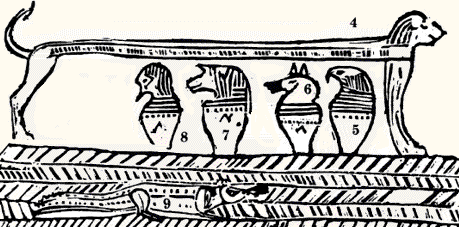William Appleby was a faithful Mormon missionary who visited Joseph Smith in Nauvoo. He received instructions from Joseph Smith about the papyrus and toured the Egyptian exhibit on display in May of 1841. He meticulously recorded details about the relics to include the mummy, papyrus, and Book of Abraham translations. On page 72 of of his ruler lined journal he wrote:
William Appleby wrote:The male mummy was one of the Ancient –
Pharaoh’s of Egypt, and a Priest, as he is embalmed with his tongue
extended, representing a speaker. The females were his wife and two
daughters, as part of the writing has been translated, and informs
us, who they were, also whose writing it is, and when those mummies
were embalmed, which is nearly four thousand years ago
Please note, Appleby must have kept his journal current in real time as the details of his journal are quite precise -- therefore, his firsthand information was recorded in Nauvoo during his short visit. It's obvious that Appleby was keeping a record of what happened when it happened. He saw the mummies, papyrus, and translation of the Book of Abraham -- there can be no doubt that he was eyewitness to those thing and recorded his experiences right away, without delay.
Appleyby wrote:Today I paid Br. Joseph a visit, received instruction concerning 'Baptism for Dead.' Read the revelation as given by the Lord last January concerning the same, and recorded in the 'Book of the Law of the Lord' viewed four mummies, one male and three females, brought from ancient Thebes in Egypt, saw the rolls of papyrus, and the writings thereon, taken from off the bosom of the male mummy, being some of the writing of ancient Abraham and of Joseph, that was sold into Egypt. The writings are chiefly in the Egyptian language, with the exception of a little Hebrew, I believe. They give a description of some of the scenes of ancient Egypt, of their worship, their idol gods, and cetera. The writings are beautiful and plain, composed of red, and black ink. There is a perceptible difference between the writings. Joseph appears to have been the best scribe.
Then, amazingly on the next page of his journal (73) there is a written transcription of several verses of the first chapter of the Book of Abraham. Keep in mind, this is prior to official publication 10 months later! Appleby records verses 5-9 almost exactly as it appears in the Times and Seasons. These clips are photographed
here for download or you can view them here on
Brian Hauglid A Textual History of the Book of Abraham: Manuscripts and Editions.
Now, Hauglid leaves a door open allowing for these verses from the Book of Abraham to have been recorded at a later date as part of a backdating process. But I hardly think so and when putting the pieces together and looking at the clues, it's obvious that Appleby was recording his journal in real time.
Hauglid wrote:William Appleby journal, dated 5 May 1841, contains Abraham 1:15–31 (1-9 Times and Seasons). This pericope is internally numbered according to the Times and Seasons, but may predate it. Even though it is placed chronologically before the Times and Seasons, at present, it cannot be definitively determined whether Washington predates the Times and Seasons or was backdated.
Hauglid wrote:Editorial Note Washington, catalogued as MS 1401 in the Church History Library, contains Abraham 1:15–31; dated 5 May 1841 (but see below); handwriting of William I. Appleby; 3 lined pages in journal. Washington contains the exact paragraph numbering as the first installment in the Times and Seasons, suggesting that Appleby inserted the Abraham text after its publication in 1842. This is quite possible, as Appleby used the word insert here and in other entries in his journal when he provides additional material. Many of the insertions in his journal, including the Abraham text, likely coincide with Appleby’s later efforts to produce his memoirs. Because the text exhibits some minor variation from the Times and Seasons and the Abraham manuscripts, it is included in this study. However, if Appleby backdated the entry and merely copied the text from the Times and Seasons, it would be of negligible significance to the textual history of the Book of Abraham. To give further context to the Abraham material in Appleby’s journal, more of the journal entry is included in appendix 4.
Hauglid details the textual variations but I would like to make a comparison to show that what Appleby recorded in May of 1841 had to have been a different transcript than the final one used for the 1842 publication in the Times and Seasons. In other words, Appleby didn't back date and copy from the Times and Seasons! Although the textual variations cited as follows are rather minor, they do show a marked difference in what Appleby's eyes
saw and
wrote compared to what came later in the Times and Seasons whereby the final editing was by Smith & Taylor. Interesting to note that Applyby's citation of the Book of Abraham also has multiple examples of using quotation marks which are not used in the publication that came later. So, Appleby either used these quotes by copying them from a transcript he was copying from or he made them up out of thin air according to his own whims. I chose the first.
Appleyby
journal compared to printed Times and Seasons:
1.
Jehovah vs. JEHOVAH
2.
and vs. &
3.
and vs. &
4.
Father vs. father
5.
Altar vs. altar
6.
Priest vs. priest
7.
Eldest vs. eldest
8.
Judged vs. judged
9. Justly vs. justly
10.
Records vs. records
11.
patriarchs vs. Patriarchs
12.
Knowledge vs. knowledge
13.
Kept vs. kept
Now, with that said, I will introduce an entirely new description of what William Appleby actually saw in the Joseph Smith papyrus of Facsimile No.1.
Hold on to your seats, folks. It's going to get interesting. Damn the apologists!




 ......................
......................